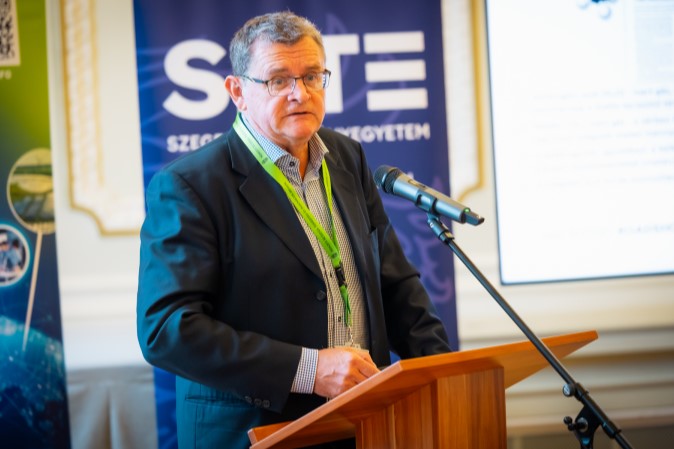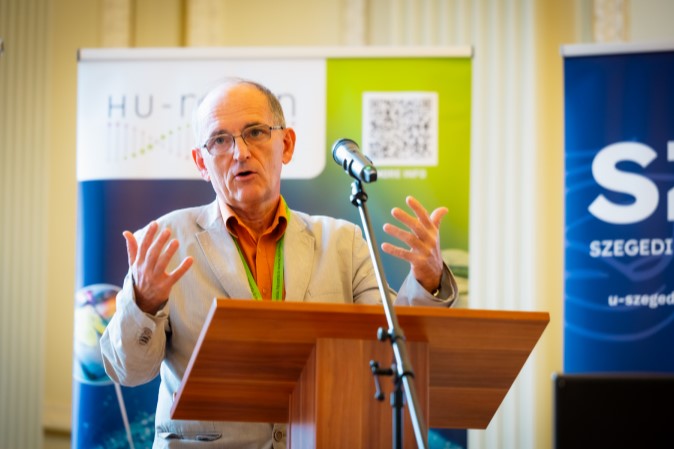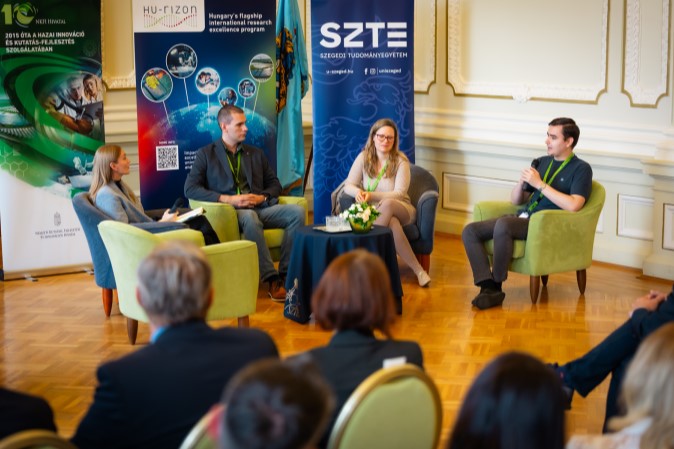The objectives of the Hu-rizon Programme and the successful project proposals of the research groups at the Centre of Excellence for Interdisciplinary Research, Development and Innovation (IKIKK) of the University of Szeged (SZTE) were presented on 25 September at the first stop of the nationwide roadshow organised by the National Research, Development and Innovation Office (NRDI Office), held at the University of Szeged.
In the first year of the HU-rizon Programme, eight successful applications from the University of Szeged accounted for one-third of all winning applications. The University of Szeged was the only institution in Hungary whose research groups received funding in all focus areas of the HU-rizon Programme, making it the most successful university in the country.
As the first year of the programme draws to a close, the National Research, Development and Innovation Office (NRDI Office), managing the funding scheme, launched a roadshow where Hungarian higher education institutions present their winning research projects. The first stop of the series was hosted by the University of Szeged.
In a video message welcoming the event, László Bódis, Deputy State Secretary for Innovation, referred to HU-rizon as a flagship programme aimed at integrating the Hungarian research ecosystem into the international research landscape. In 2024, a total of 112 proposals were submitted under the programme, and 30 research projects received a total of HUF 12 billion in funding. László Bódis also announced that in the second year of the Hu-rizon programme, an even higher number of applications—132 research proposals—were submitted, with the funding decisions to be made in November this year.
The participants of the winning project were welcomed by Prof. Dr. László Rovó, Rector of the University of Szeged. He stated that the grants were well-deserved adding that the excellence of the University of Szeged is further demonstrated by its recognition this year as the most innovative university in Hungary, as well as by its continued dominance as the top-ranked Hungarian university in the Academic Ranking of World Universities (ARWU). The rector individually praised each of the eight winning research projects of the SZTE IKIKK (described below), noting that they address areas related to key global issues. Highlighting their research excellence, he pointed out that the state-of-the-art infrastructure of the Centre of Excellence for Interdisciplinary Research, Development and Innovation of SZTE enables the university’s projects to remain competitive and become valuable partners for major international organizations.
 |
| Prof. Dr. László Rovó, Rector, University of Szeged |
At the event, Dr. László Lengyel, Vice President for Science and International Affairs at the NRDI Office, emphasized that beyond the scientific collaboration goals of the programme, special importance is placed on involving young researchers and on fostering a nationwide community among participants of the HU-rizon research programmes, where they can share their experiences with one another. Dr. Borbála Schenk, Head of the Department for International Cooperation at the NRDI Office, introduced the operational team of the HU-rizon Programme and noted that under the hashtag #WeareHUrizon, they are also building a researcher network involving the research groups supported by the programme.
 |
| Dr. László Lengyel, Vice President for Science and International Affairs at the NRDI Office |
 |
| Dr. Borbála Schenk, Head of the Department for International Cooperation at the NRDI Office |
Dr. Judit Fendler, Chancellor of the University of Szeged, presented the Advanced Core Facilities (ACF) system of the SZTE IKIKK, highlighting it as a key infrastructure supporting the university’s successful participation in the HU-rizon Programme. According to the Chancellor, this infrastructure serves university-wide strategic goals and enhances market competitiveness by attracting top international researchers. This involves scaled, structured and marketable access to research infrastructure, added Dr. Judit Fendler, noting that “marketable” also includes the attraction of international partners—since these collaborations bring in additional valuable knowledge.
 |
| Dr. Judit Fendler, Chancellor of the University of Szeged |
At the HU-rizon Day, Prof. Dr. Mihály Boros was the first to present his winning research project. The research group, led by the university professor at the Institute of Surgical Research at SZTE, aims to develop a new, non-invasive diagnostic method that analyses exhaled breath to detect diseases associated with circulatory disorders of the gastrointestinal system. The SZTE research group is working in a consortium with Heidelberg University and the Ludwig Boltzmann Institute in Austria.
 |
| Prof. Dr. Mihály Boros |
Representing Dr. Attila Gácser’s research group, Dr. Renáta Tóth, microbiologist, presented a project conducted in collaboration with the University of Pennsylvania (USA) and King’s College London (UK) seeking to develop new methods for treating and preventing Candida fungal infections. The research focuses on the development of an mRNA-based vaccine against Candida. Another goal of the research is to strengthen mucosal tissue using mRNA-based therapy to make it more resistant to the damaging effects of Candida. Currently, no effective antifungal vaccine exists in the world. If successful, the vaccine developed by Dr. Attila Gácser’s team as part of the Hu-rizon Programme could become the world’s first vaccine against Candida.
 |
| Dr. Renáta Tóth |
Dr. Klaudia Farkas is coordinating research on the treatment of inflammatory bowel diseases within a consortium consisting of the University of Szeged (SZTE), the University of Tokyo (Japan), and McGill University (Canada). The project aims to develop new antioxidant nanoenzymes – nanoparticles with enzymatic activity – to treat oxidative stress associated with bowel diseases. This approach could lead to a breakthrough in the treatment of conditions such as Crohn’s disease. On SZTE’s side, Dr. István Szilágyi is leading the development of the nanoenzymes, while Dr. József Maléth’s research group is conducting the preclinical studies.
Dr. József Maléth, a researcher at the Albert Szent-Györgyi Medical School of SZTE, is also participant of a project in consortium with the University of Cambridge and Ulm University, investigating the impact of micro- and nanoparticles – originating from plastic waste degradation – on the human body. Presenting the project, Dr. Maléth highlighted that there is currently limited scientific data on the health effects of nanoplastics. It is still unknown whether potential effects depend on factors such as the amount of, duration of exposure to, composition, structure or shape of the nanoplastic particles. The project is highly interdisciplinary, with researchers from SZTE IKIKK examining the effects of nanoparticles from genetic, pharmaceutical, analytical chemistry, optical, and even legal perspectives.
 |
| Dr. József Maléth |
Dr. Gergely Röst’s research programme aims to develop a methodology for a rapid and coordinated response to potential future pandemics. In this project, the University of Szeged is working in consortium with Kyoto University (Japan) and Yale University (USA). At the presentation, Dr. Gergely Röst explained that within the RAPID-GRIP project, the goals include the swift identification of pandemics posing global risks, the development of response strategies, and – crucially– the acceleration, synchronization and integration of these actions within a unified international framework.
 |
| Dr. Gergely Röst |
Dr. Zoltán Bozóki, university professor at the Department of Optics and Quantum Electronics at SZTE Faculty of Science and Informatics (SZTE TTIK), is working with his research group to improve the sensitivity of photoacoustic measurement techniques in a consortium with the University of Glasgow, National University of Singapore, and Seoul National University. Photoacoustics is based on detecting sound generated during light absorption; by utilizing metamaterials, the project aims to make this method even more precise. The photoacoustic measurement technique is a patented invention developed at the SZTE TTIK Department of Optics and Quantum Electronics.
 |
| Prof. Dr. Zoltán Bozóki |
Dr. István Szilágyi, associate professor at the Department of Physical Chemistry and Materials Science at SZTE TTIK and leader of the MTA-SZTE "Lendület" Biocolloids Research Group, is investigating micro- and nanoplastic contamination in agriculture in a consortium with researchers from the University of Queensland (Australia) and the École Polytechnique Fédérale de Lausanne (Switzerland). This research project, together with the physiological studies led by Dr. József Maléth, is part of the SZTE IKIKK nanoplastic incubation programme. Within this framework, Dr. István Szilágyi’s group focuses on the detection, effects, tracking and the possibilities for the removal of nanoplastics. This project is particularly timely given the impact of plastic pollution on agricultural productivity and food safety.
 |
| Dr. István Szilágyi |
Dr. Márk Jelasity, university professor and head of the Department of Artificial Intelligence at the University of Szeged, researches the “black box” phenomenon observed in large language models with his team. His consortium partners are Rutgers University (USA) and Nanyang Technological University (Singapore). In his presentation, Dr. Márk Jelasity explained that the knowledge embedded in large language models – which can sometimes perform complex tasks with surprising efficiency – is not transparent. This knowledge arises from being trained on massive amounts of data rather than from receiving information in a deliberately structured way. Dr. Jelasity’s research focuses on investigating the internal knowledge representation of language models, seeking to understand what kind of world model emerges from the relationships between words and concepts in artificial intelligence. According to him, understanding this could help mitigate security issues in the models, and in some cases, enable learning from AI systems for tasks that surpass human capabilities.
 |
| Prof. Dr. Márk Jelasity |
At the HU-rizon Roadshow, Flóra Csesznok, a colleague from the NRDI Office’s International Cooperation Department, hosted a roundtable discussion with PhD students and young postdoctoral researchers involved in SZTE HU-rizon projects, as well as participants including AI researcher András Balogh, mathematician Nóra Juhász and medical researcher Attila Rutai.
The afternoon program concluded with an interactive skill-building workshop led by Dr. Borbála Schenk and conducted by staff from the NRDI Office for interested researchers.
 |
| Flóra Csesznok, András Balogh, Nóra Juhász and Attila Rutai |
Photo: Ádám Kovács-Jerney






